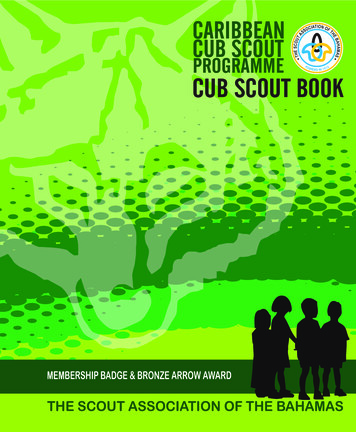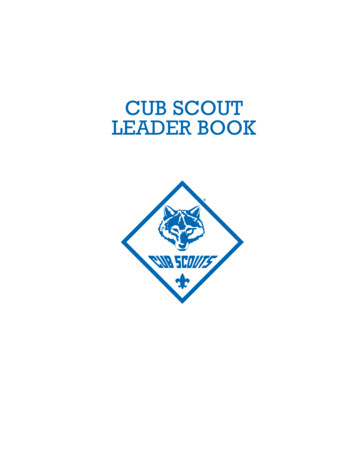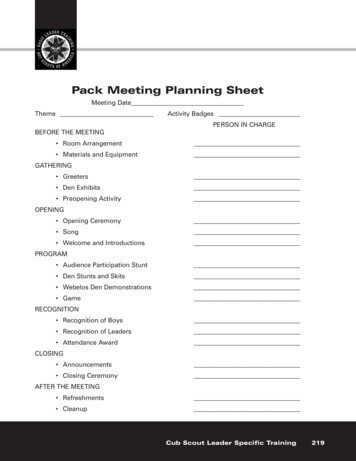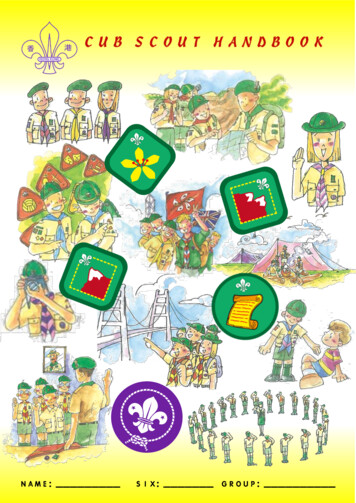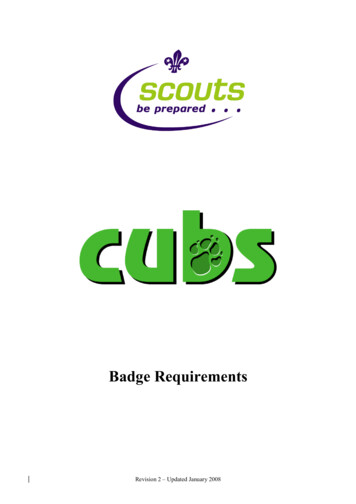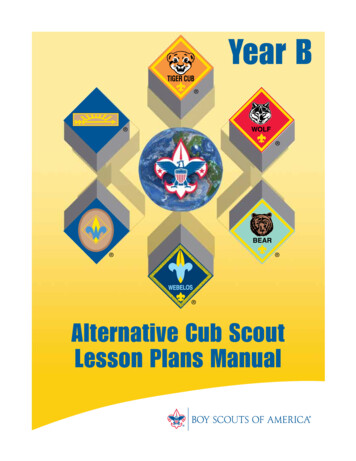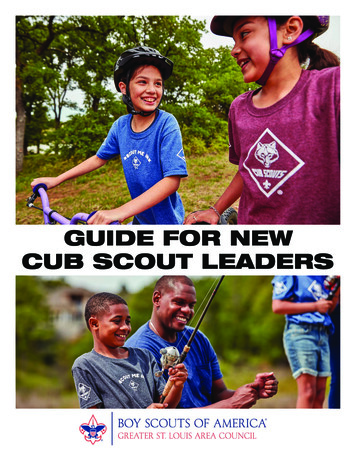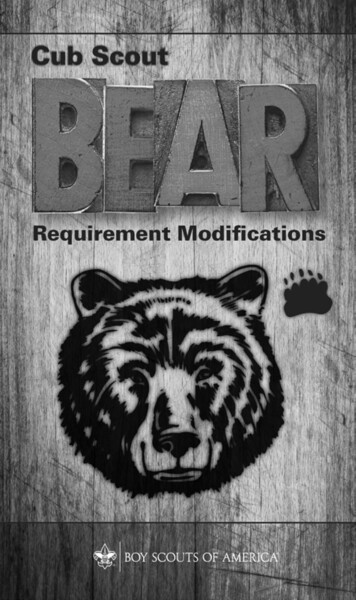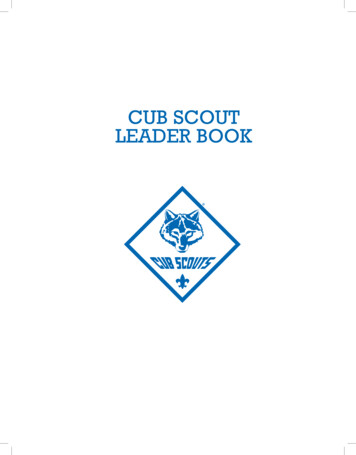
Transcription
Cub ScoutLeader Book
ContentsIntroductionLeaders1. Boy Scouts of America:A Program for Families1-12. Cub Scouting: Purposes,Methods, and Ideals2-13. Cub Scouting:A Positive Place3-14. Character Development4-15. Family Involvement5-16. History of Cub Scouting6-1Administration7. Organization of Cub Scouting7-18. Policies of Cub Scouting8-19. Pack Relationships9-123. Leadership23-124. Program Planning24-125. Cub Scout LeaderRecognition Awards25-126. Cub Scout Leader Training26-127. Youth Protection27-128. Unit LeadershipEnhancements28-1Activities29. Den and Pack Activities29-130. Cub Scouting’s BSAFamily Program30-131-110. Den and Pack Management10-131. Cub Scout Academics andSports Program11. Pack Finances11-132. Outdoor Activities32-112. Uniforms and Insignia12-133. Cub Scout Camping33-113. Health and Safety13-114. Water Safety14-1Boys15. Cub Scout–Age Boys15-116. Managing Boys16-117. Cub Scouts With Disabilities17-118. Advancement18-119. The Tiger Cub Program19-120. The Wolf and Bear Programs20-121. The Webelos Scout Program21-122. Webelos Scout Transitionto Boy Scouting22-1AppendicesAppendix 1. Resources, Forms,and Applications34-1Appendix 2. Glossary ofCub Scouting Terms35-1IndexIndex-1
introduction—Chapter 1Boy Scouts of America:A Program for FamiliesPurpose of the Boy Scouts of America,1-1Parts of the BSA Program, 1-1Purpose of the BoyScouts of AmericaWebelos Scouting is a family- and home-centered part of theBSA program that develops ethical decision-making skills forfourth- and fifth-grade (or 10-year-old) boys. Webelos Scoutsparticipate in more advanced activities that begin to preparethem to become Boy Scouts.The purpose of the Boy Scouts of America—incorporated on February 8, 1910, and chartered by Congress in1916—is to provide an educational program for boys andyoung adults to build desirable qualities of character, totrain in the responsibilities of participating citizenship, andto develop personal fitness.Parts of theBSA ProgramTiger Cubs is a family- and home-centered part of the BSAprogram that encourages ethical decision-making skills forfirst-grade (or 7-year-old) boys. These boys participate inactivities with an adult partner, usually a parent. Tiger Cubsemphasizes shared leadership, learning about the community,and family understanding.Cub Scouting is a family- and home-centered part of theBSA program that helps develop ethical decision-making skills for boys in the second and third grades (or whoare 8 and 9 years old). Activities emphasize character development, citizenship training, and personal fitness.A Program for Families Boy Scouting is the part of the BSA program for boys11 through 17 years of age. Boys also may become BoyScouts if they have earned the Arrow of Light Award orhave‑completed the fifth grade or are 11–17 years of age. BoyScouting is designed to achieve the aims of Scouting througha vigorous outdoor program, using peer group leadership withthe counsel of an adult Scoutmaster.Varsity Scouting is a part of the BSA program for youngmen 14 through 17 years of age. Emphasis is on advancement, high adventure, personal development, service, andspecial programs and events.Venturing is the part of the BSA program for young men andwomen who are 14 (and have completed the eighth grade)through 20 years of age. Venturing is designed around sixexperience areas: social, citizenship, service, leadership, fitness, and outdoor. Venturing can provide positive experiencesthrough exciting and meaningful activities that help youthgrow to adulthood, pursue their special interests, developleadership skills, and become good citizens.1-1
introduction—Chapter 2Cub Scouting: Purposes,Methods, and IdealsIntroduction to Cub Scouting, 2-1The Purposes of Cub Scouting, 2-1The Methods of Cub Scouting, 2-2Cub Scouting Ideals, 2-3The Cub Scout Promise, 2-3The Law of the Pack, 2-3The Cub Scout Motto, 2-4Cub Scouting Basics, 2-4The Cub Scout Sign, 2-4The Cub Scout Salute, 2-4The Cub Scout Handshake, 2-4The Living Circle, 2-4Webelos, 2-5The Blue and Gold Colors, 2-5Introduction toCub ScoutingWelcome to Cub Scouting! You are one of more thanhalf a million adult leaders working with more than2 million Cub Scouts in the United States today.Boys join Cub Scouting for excitement, to be with friends,and to have fun. But “having fun” includes more than justactually having a good time. It also means feeling acceptedby a group regardless of race, class, religion, culture, or anyother elements. Fun also means boys discovering that theycan perform challenging tasks.When Robert Stephenson Smyth Baden-Powell foundedScouting, he drew on his military experience. He recognizedthat boys would want to become Scouts because they are“keen for adventure and outdoor sports they want to havefun and learn how to live outdoors.” He realized that Scoutingwas a game with a purpose—a game in which the purpose ofScouting manifests itself today in the ideals and values foundin the Cub Scout Promise, the Law of the Pack, the ScoutOath and Law, the Scout motto, and the Scout slogan.Cub Scouting is a character-building organization thatembraces the values of citizenship, compassion, cooperation,courage, faith, health and fitness, honesty, perseverance, posi-Purposes, Methods, and Ideals Cub Scouting: What It’s All About, 2-5Cub Scouting Is for Boys, 2-5Cub Scouting Is for Families, 2-5Cub Scouting Is Fun, 2-5Cub Scouting Has Ideals, 2-6Cub Scouting Provides Adventure, 2-6Cub Scouting Helps Boys Develop Interestsand Skills, 2-6Cub Scouting Has an Advancement Plan, 2-6Cub Scouts Belong, 2-6Cub Scouting Teaches Boys to ReachOut, 2-6Cub Scouting Teaches Duty to God andCountry, 2-6Cub Scouting Provides a Year-RoundProgram, 2-6Cub Scouting Helps Organizations, 2-6Summary, 2-6tive attitude, resourcefulness, respect, and responsibility (see“Cub Scouting’s 12 Core Values,” page 4-2). It is expectedthat boys in Scouting will not only have fun and experienceadventure but will also accept Scouting’s value system. Highquality leadership is the key to youth acquiring and internalizing the ideals and values of the Boy Scouts of America.Adults become Cub Scout leaders for a variety of reasons.Many join the Scouting movement when their sons becomeold enough to join a pack. Some were Scouts or members ofsimilar youth organizations during their own youth. Othersare recruited into taking a leadership position. Yet others thinkit is the right thing to do. Regardless of why adults join Scouting, new volunteers become confident and proficient throughtraining, and through support from other adult Scouters. Morethan ever before, youth need to develop positive relationshipswith caring, concerned, and compassionate adults.The Purposes ofCub ScoutingSince 1930, the BSA has helped younger boys through CubScouting, which is a year-round family-oriented part of theBSA program designed for boys who are in first through fifth2-1
grades (or are 7, 8, 9, and 10 years of age). Parents, leaders,and organizations work together to achieve the 10 purposesof Cub Scouting.The Purposes of Cub Scouting1. Character Development2. Spiritual Growth3. Good Citizenship4. Sportsmanship and Fitness5. Family Understanding6. Respectful Relationships7. Personal Achievement8. Friendly Service9. Fun and Adventure10. Preparation for Boy ScoutsAll the activities leaders plan and boys enjoy should relateto one or more of these purposes. These purposes help usachieve the overall aims of the BSA of character development, citizenship training, and personal fitness.The Methods ofCub ScoutingCub Scouting uses eight specific methods to achieve Scouting’s aims of helping boys build character, learn the responsibilities of citizenship, and develop personal fitness. Thesemethods are incorporated into all aspects of the program.Through these methods, Cub Scouting happens in the lives ofboys and their families.The Methods of Cub Scouting1. Living the Ideals2. Belonging to a Den3. Using Advancement4. Involving Family and Home1. Living the IdealsPractices such as the Cub Scout Promise, the Law of thePack, the Cub Scout sign, handshake, motto, and salutehelp establish and reinforce shared values and ideals ofCub Scouting.2. Belonging to a DenBoys need and want to belong to a group. The den is theplace where belonging is created through practicing skills,exploring interests, learning values, and forming friendships. In the den, boys are given opportunities to work withothers, to do their best, and to have fun.3. Using AdvancementPositive recognition is important for boys and theirfamilies. The advancement plan provides fun and challenging experiences, by helping boys gain self-motivationand a sense of personal achievement, while strengtheningfamily relationships.4. Involving Family and HomeFamily involvement is an essential part of Cub Scouting.Parents, guardians, siblings, and other family membersprovide leadership, support, and resources. Active familyparticipation ensures that boys have a successful experience in Cub Scouting.5. Participating in ActivitiesBoys participate in a variety of den and pack activities,such as games, projects, skits, songs, outdoor activities,and service experiences. Cub Scout activity programs provide opportunities for growth in character development,citizenship training, and physical fitness.6. Serving Neighborhood and CommunityBoys are connected to their neighborhoods and communities through their activities and service. In turn, thisnetwork of resources supports the growth and development of the boys.7. Wearing the UniformScout uniforms help build pride, loyalty, and self-respect. Wearing the uniform encourages a neat appearance,a sense of belonging, and a shared identity for both theboys and the leaders.8. Making Character ConnectionsThroughout the program, leaders learn to identify andutilize character lessons in activities, so that boys can learnto know, commit, and practice the twelve core values ofCub Scouting. Character Connections are included in allthe methods of Cub Scouting.5. Participating in Activities6. Serving Home and Neighborhood7. Wearing The Uniform8. Making Character Connections2-2Introduction
Cub Scouting IdealsThe Cub Scout Promise, the Law of the Pack, and the CubScout motto are ideals that are related to everything a CubScout does. These ideals are not tests to be passed in order toqualify for induction; they are principles that boys learn andincorporate into their everyday lives.Take advantage of every opportunity to mention how anactivity or service project in which the boys are involvedembodies or shows an aspect of the Cub Scout Promise, theLaw of the Pack, or the Cub Scout motto. Help them see thatliving the ideals of Cub Scouting is a good way to live.The Cub Scout PromiseI, [name] , promise to do my bestTo do my duty to God and my country,To help other people, andTo obey the Law of the Pack.This promise helps Cub Scouts develop a sense of spiritualawareness, loyalty, unselfishness, self-discipline, and serviceto others.As a leader, your obligation to a boy joining Cub Scoutingis to lay a firm foundation for the promise he will make eachtime he recites the Cub Scout Promise. This Promise, with thewords changed slightly, will follow him into Boy Scoutingand Venturing, and perhaps into a leadership role.As you talk with a boy who has chosen to join Cub Scouting, you have an opportunity to provide a good influencewhen his young mind is eager to learn. And later, as you workwith him in den and pack meetings, you will have a chanceto reinforce his understanding of the Cub Scout Promise. Youwill have many opportunities to remind him to “do his duty,”“do his best,” and “help other people.” Explain the words insimple language that he will understand.I promise—A promise is keeping your word. It’s not right tomake a promise and then not do your best to keep it.To do my best—Your best is not the same as someone else’sbest. Try to better your own record, rather than merely tryingto do better than someone else. It makes you feel good to doyour best.To do my duty to God—This phrase means to remember tothank God for good friends, good health, and all the things heprovides for us. We should also thank him for our family andall others who love us and help us. Going to worship servicesis another way of doing our duty to God. We should respectother people’s religious beliefs even if they are different fromour own.And my country—Duty to country starts with being a goodcitizen. This means caring about the people in our communities and helping those in need. Good citizenship also meansobeying the law and using our country’s resources carefully.Purposes, Methods, and Ideals We show love for our country by respecting and saluting theU.S. flag and standing at attention when our national anthem,“The Star-Spangled Banner,” is played.To help other people—This phrase means helping at homeby doing things like taking out the garbage or making yourbed without grumbling. It can also include offering to befriends with a new student in school, making holiday cards forolder people, or raking leaves or clearing snow for a neighbor.It can mean providing games for children living in sheltersor collecting food for people who don’t have enough to eat.Helping others is not always an easy thing to do. We mustthink about other people instead of ourselves—even when itmight be inconvenient. It means treating other people as wewould want them to treat us.And to obey the Law of the Pack—Obey means to do whatyou’re supposed to do, and to do what parents and otheradults ask you to do. When you obey the law, you do whatthe law says. A Cub Scout should follow the laws of the land,the rules in his school, the rules in his home, and the rules inhis den and pack.The Law of the PackThe Cub Scout follows Akela.The Cub Scout helps the pack go.The pack helps the Cub Scout grow.The Cub Scout gives goodwill.The Cub Scout follows Akela—In Cub Scouting, Akela(pronounced Ah-KAY-la) means “good leader.” To a CubScout, Akela is a parent, teacher, religious leader, or CubScout leader. Akela is anyone who has shown ability andwillingness to be a good leader for Cub Scouts to follow.(See “The Story of Akela and Mowgli” in the Wolf Cub ScoutBook.)One must first learn to be a good follower in order to be agood leader. The key word in this phrase of the Law of thePack is follows. When following, a Cub Scout should choosea good leader to emulate.The Cub Scout helps the pack go—Cub Scouts help thepack go by being loyal members, attending all meetings, following the leaders, and making the pack better because theybelong. It means doing one’s share. By helping the pack, CubScouts have more fun and feel satisfied. The key word in thisphrase is helps.The pack helps the Cub Scout grow—Cub Scouting helpsboys grow into better people. They learn how to do newthings and to reach out to others. The key word in this phraseis grow.The Cub Scout gives goodwill—It’s a good feeling for aboy to do what he is expected to do. It’s an even better feeling when he does more than he is expected to do. Help boys2-3
look for ways to make other people happy. The small thingsare just as important as the big ones. Anything that makes lifea little easier or more pleasant for someone else is goodwill.The key word in this phrase is gives.The Cub Scout SaluteThe Cub Scout MottoCub Scout saluteDo Your Best.Doing your best is one of the most important things forthe Cub Scout to learn. Boys often become so interested inwinning that they fail to see the importance of doing the bestthey can at everything. One boy’s best might be quite differentfrom another boy’s best. Help the boys see that no one canfind fault with them if they always do their best.Cub Scouting BasicsThe Cub Scout SignThe salute is made by joining the index and middle fingersof the right hand (holding the other fingers with the thumb)and touching them to the cap visor or forehead. The hand isheld the same as for the Cub Scout sign, except the two fingers are together.The Cub Scout salute is used to salute the flag when inuniform and to show respect to den and pack leaders. It canbe used when greeting other Cub Scouts.The Cub Scout HandshakeCub Scout signCub Scout handshakeThe Cub Scout sign is made with the right arm held highand straight up above the shoulder, with the index and middlefingers forming a V.The other fingers are held with the thumb.The two extended fingers stand for the parts of the CubScout Promise, “to help other people” and “to obey.” Theyalso stand for the two alert ears of a wolf. This is the sign ofCub Scouts all over the world.The Cub Scout sign should be given when repeating theCub Scout Promise or Law of the Pack. It is also used in theLiving Circle and other ceremonies.Use the sign to get the boys’ attention or to encourage boysto be quiet in meetings. When you raise the sign, boys shouldbecome quiet and make the sign themselves. Reinforce thisuse of the sign by complimenting the first Cub Scout whoreacts by making the sign when you do.2-4The handshake is done by putting the index and middlefingers of the right hand against the other person’s wrist whenshaking hands.Cub Scouts and Cub Scout leaders use this handshakeeverywhere in the United States. The handshake signifies thatthose who use it help others and obey the Law of the Pack.The Living CircleThe Living Circle is an important Cub Scout ceremony thatmay be used occasionally as an opening or closing for a denor pack meeting. It reminds the boy of the friendships he ismaking and links him with all other Cub Scouts.Introduction
The Blue and Gold ColorsBlue and gold are the Cub Scout colors. They have specialmeaning, which you and the boys should understand andwhich will help boys see beyond the fun of Cub Scouting toits ultimate goals: The blue stands for truth and spirituality, steadfast loyalty,and the sky above. The gold stands for warm sunlight, good cheer, andhappiness.Cub Scouting:What It’s All AboutCub Scouting Is for BoysLiving CircleLeft-handthumb gripTo form a Living Circle, Cub Scouts (and leaders) faceinward in a close circle. With the right hand, each persongives the Cub Scout sign. They turn slightly to the right andextend left hands into the circle. Each thumb in the circleis pointed to the right, and each person grasps the thumbof the person on his left, making a complete Living Circlehandclasp. The Promise, Law of the Pack, or motto can thenbe repeated.The Living Circle also can be used by moving all of theleft hands up and down in a pumping motion while the CubScouts say, “A-ke-la! We-e-e-ll do-o-o ou-r-r best,” snappinginto a circle of individual salutes at the word best.Cub Scouting is for boys, and each boy is different. CubScouts come in all sizes, shapes, and colors and from avariety of backgrounds. There are no “average” boys. CubScouting is easily adaptable to a boy with a physical, mental,or emotional limitation, just as it is adaptable to boys whocome from low-income, urban, or rural areas. There is littledoubt that Cub Scouting can be one of the most valuable aidsto the physical and mental development of a youngster withspecial needs.Cub Scouting Is for FamiliesThe family is an important influence on our nation’s youth.There are many different types of family structures in today’sworld. Scouting is a support to all types of families as wellas to organizations to which families belong. We believein involving families in the training of youth, and we aresensitive to the needs of present-day families. Cub Scoutingprovides opportunities for family members to work and playtogether, to have fun together, and to get to know each othera little better.Cub Scouting Is FunWebelosWebelos (pronounced WEE-buh-lows) is a word that hastwo meanings for Cub Scouts: Webelos Scouts are the older boys in the pack who aremembers of a Webelos den, where they start preparing tobecome Boy Scouts. Webelos is also the name of the badge of rank a WebelosScout can earn.Boys join Cub Scouting because they want to have fun.For boys, however, fun means a lot more than just having agood time. Fun is a boy’s code word for the satisfaction hegets from meeting challenges, having friends, feeling good,and feeling he is important to other people. While the boysare having fun and doing things they like to do, they alsolearn new things, discover and master new skills, gain selfconfidence, and develop strong friendships. Cub Scouting isa positive place where friends and leaders accept and supporta boy.Webelos means “We’ll Be Loyal Scouts” because theword is formed by using the first letters of the words in thatphrase. It reminds Cub Scouts that they will someday beBoy Scouts.Purposes, Methods, and Ideals 2-5
Cub Scouting Has IdealsCub Scouting Teaches Boys to Reach OutCub Scouting has ideals of spiritual and character growth,citizenship training, and personal fitness. The Cub ScoutPromise is a pledge of duty to God and family. The Law ofthe Pack is a simple formula for good Cub Scouting and goodcitizenship. The Cub Scout motto, “Do Your Best,” is a codeof excellence. Symbols, such as the Cub Scout sign, CubScout salute, and the Living Circle, help boys feel a part of adistinct group and add to the appeal of belonging to a widelyrespected organization.Cub Scouting provides opportunities for boys to reach outinto a wider community while maintaining a link with securefoundations such as the home, a religious organization, anda school. Cub Scouting helps boys become full members oftheir communities as they take part in service projects andother community-related activities. They get to know theircommunity better and recognize the importance of goodcitizenship.Cub Scouting Provides AdventureCub Scouting helps fulfill a boy’s desire for adventure andallows him to use his vivid imagination while taking part inskits, games, field trips, service projects, outdoor activities,and more. The use of a monthly theme lets a boy play therole of an astronaut, clown, explorer, scientist, or other exciting character. Boys find adventure in exploring the outdoors,learning about nature, and gaining a greater appreciation forour beautiful world.Cub Scouting Helps Boys DevelopInterests and SkillsCub Scouts learn many useful skills. They develop abilityand dexterity, and they learn to use tools and to follow directions. Recognition and awards encourage them to learn abouta variety of subjects, such as conservation, safety, physicalfitness, community awareness, sports, and religious activities.These interests might become a hobby or even a career laterin life.Cub Scouting Has an Advancement PlanThe advancement plan recognizes a boy’s efforts andachievements. It provides fun for the boys, teaches them todo their best, and helps strengthen understanding as familymembers work with boys on advancement requirements.Badges are awarded to recognize advancement, and boys liketo receive and wear these badges. The real benefit comes fromthe worthwhile things the boy learns while he is earning thebadges, as his self-confidence and self-esteem grow.Cub Scouts BelongBelonging is important to boys. They like to be acceptedas part of a group. In Cub Scouting, boys belong to a smallgroup called a den where they take part in interesting andmeaningful activities with their friends. In the den they learnsportsmanship, good citizenship, and loyalty. They learn howto get along with others and how to do their best for themselves and their den. Cub Scouts also belong to a pack, whichis a larger group made up of several dens.2-6Cub Scouting Teaches Duty toGod and CountryThe BSA believes that no member can grow into the bestkind of citizen without recognizing an obligation to God, andencourages both youth and adult leaders to be faithful in theirreligious duties.The Scouting movement has long been known for serviceto others. Scouting believes that patriotism plays a significantrole in preparing our nation’s youth to become useful andparticipating citizens. A Cub Scout learns his duty to God,country, others, and self.Cub Scouting Provides aYear-Round ProgramCub Scout packs renew their charters every year, and members are registered for one year at a time. Boys are entitled toa full year of program fun and activities. Summer den andpack activities are informal and often held outdoors, andfamilies are often asked to help with the leadership. Eventhough some families will be on vacation at various timesduring the summer, enough people will be around to enjoyand benefit from the activities. Boys have more free timeduring the summer, so it is a great time for Cub Scouting.Districts and councils help support the year-round packprogram by providing opportunities such as day camp andresident camp.Cub Scouting Helps OrganizationsCub Scouting is a resource program for community organizations. The Scouting program is available to organizationswith similar interests and goals. They can use the program tofurther their outreach and help them achieve their objectivesfor young people in the community.SummaryCub Scouting provides a framework with guidelines uponwhich we build. When we are satisfied that we have builta full and rich program that is varied and exciting for theboys, we have just begun. All of the activities will affect thegrowth and development of boys. We must remember that ourultimate objectives are citizenship training, characterdevelopment, and personal fitness.Introduction
As a worldwide brotherhood, Scouting is unique. It isbased on the principles of loving and serving God, of humandignity and the rights of individuals, and of recognizing theobligation of members to develop and use their potential. Itis a movement dedicated to bringing out the best in people.Cub Scouting doesn’t emphasize winning as an end result, butrather the far more demanding task of doing one’s best.Purposes, Methods, and Ideals When Scouting can help nurture courage and kindness andallow boys to play, to laugh, to develop their imaginations,and to express their feelings, then we will have helped themgrow. We want boys to become useful and stable individuals who are aware of their own potential. Helping a boy tolearn the value of his own worth is the greatest gift we cangive him.2-7
introduction—Chapter 3Cub Scouting:A Positive PlaceIntroduction, 3-1Five Guidelines for a Positive Place, 3-1A Place for Growth, 3-1IntroductionThe Boy Scouts of America emphasizes a positive placein Cub Scouting. Any Cub Scouting activity should takeplace in a positive atmosphere where boys can feel emotionally secure and find support, not ridicule, from theirpeers and leaders. Activities should be positive and meaningful and should help support the purpose of the BSA.Many boys grow up loved, respected, adequately nourishedand clothed, and properly housed. But some boys have a different experience. The environments in which some boys arereared are challenging—for a variety of economic, social, orcultural reasons. For all boys, but especially for these boys,the Cub Scout den and pack can be positive places where theycan feel emotionally secure and find support.Leaders and boys can reach a consensus on standards forprotecting each other from name calling, bullying, racialand cultural put-downs, and all forms of violence. They candiscuss and then put into practice more appropriate ways ofresolving conflicts.But the idea of Cub Scout meetings being a positive placegoes beyond merely ruling out aggression. Boys can differin many ways—racially, ethnically, socially, and culturally.They need to learn to accept and respect not only the diversityfound within their own social and cultural environments butthat of the broader community, nation, and world.Finally, using athletics as their ideal, many boys tend tothink of all outcomes as win-lose situations. Instead, theyneed to find ways, through cooperation, by which everyonecan be successful. They need to come to understand that theycan meet more of their goals and realize more success throughjoint effort and finding the middle ground.Guidelines for aPositive PlacePositive ValuesFun is an important element of Scouting. But we mustremember that everything we do with our Scouts shouldbe positive and meaningful. Activities should build selfesteem, be age-appropriate, and should not offend participants or the audience.As leaders of the Boy Scouts of America, it is our responsibility to model the values of the organization and set a highstandard for appropriateness in all Scouting activities. Whenmaking decisions, resolve to follow the high road—“If indoubt, take it out.”These are some of the things that can make activities inappropriate and unacceptable: Name-calling, put-downs, or hazing References to undergarments, nudity, or bodily functions Cross-gender impersonation that is in any way derogatory,rude, insulting, or lewd. (This is not to suggest that boyscannot dress for and play female roles when needed in askit or play, as long as good taste prevails.) Derogatory references to or stereotyping of ethnic or cultural backgrounds, economic situations, or disabilities Sensitive social issues such as alcohol, drugs, gangs, guns,suicide, etc. Wasteful, ill-mannered, or improper use of food or water “Inside jokes” that exclude some of those present Cultural exclusion—emphasis on the culture or faith of partof the group while ignoring that of the rest of the groupA Positive Place 3-1
Changing lyrics to patriotic songs (“America,” “Americathe Beautiful,” “God Bless America,” “The Star-SpangledBanner”) or to hymns and other spiritual songsA Place for GrowthThe den and pack should offer Cub Scouts a place wherethey can talk intelligently about their differences and learn torespect and appreciate them. When sensitive situations arise,parents and other adults who are competent to deal with suchsituations should be invited to attend the meetings. Often, theycan shed light on such issues and encourage understanding.During the Cub
cuB scouting ideAls, 2-3 the cub scout Promise, 2-3 the law of the Pack, 2-3 the cub scout motto, 2-4 cuB scouting BAsics, 2-4 the cub scout sign, 2-4 the cub scout salute, 2-4 the cub scout handshake, 2-4 the living circle, 2-4 Webelos, 2-5 the Blue and gold colors, 2-5 cuB scouting: WhAt it’s All
